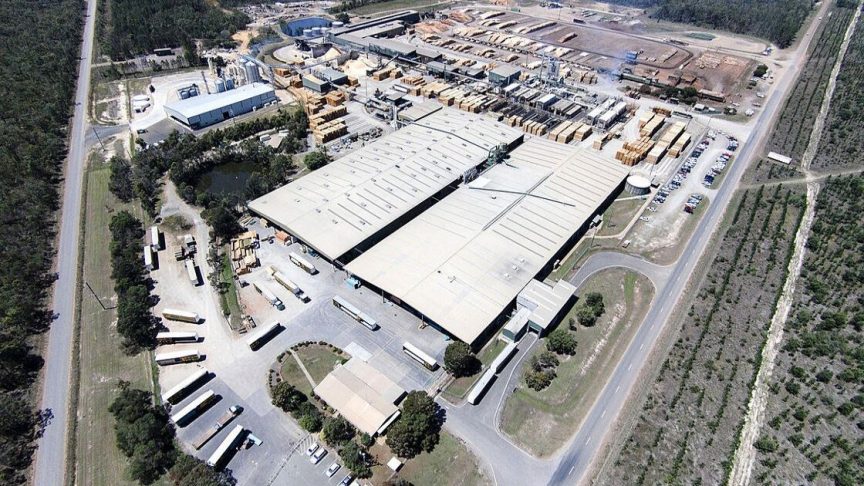In a personal letter thanking those who had contributed to the newly-published book Hyne Timber: 140 Years of Growth, fifth generation family member James Hyne says this is a snapshot of the company’s history based on past and present team members.
Yes, and I would suggest it is also a large-frame portrait of an amazing dynasty, and a worthy addition to the writer’s bookshelf alongside Hyne-sight: A History of a Timber Family in Queensland written by industry visionary James Richard Lambert Hyne (grandfather of James) who joined his father in the business in 1921 and served until his death in 1985.
“Indeed, 140 years is a significant milestone and one worth celebrating,” James Hyne said.
“Hyne has joined a league of famous brands – we are officially as old as Bushells tea, Allen’s confectionary, Drizabone and Akubra.

Admiring Hyne Timber’s 140 years of growth is Bruce Saunders, MP Maryborough, James Hyne, Hyne Timber’s stakeholder engagement manager and fifth generation family member of the company, Greig Bolderro, history book researcher, and Cr George Seymour, Fraser Coast Mayor.
“And there is much more history to capture as we head toward Hyne’s 150 years!”
In a foreword, the Hyne family says the book provides an important chance to reflect on the past and look to the future.
“Starting at the beginning, the legacy of founder Richard Matthews Hyne (RM) came from his clear vision to develop a strong forest industry which was driven by a love for the timber industry and people who work in it,” they said.
RM, who was Parliamentary Member for Maryborough in 1889, earned the title “Father of Forestry” after he moved a successful motion calling for the creation of a Department of Forestry “to meet the challenges of an approaching timber shortage” – challenges facing the industry right now.
The book is a profusely illustrated recollection of the many milestones – historic and present – from the early days of forestry and timber shipping to the development of world-class sawmilling technology and distributorship.
But what brought special memories was a chapter on Hyne’s sawmill at Tuan, a coastal rural town in Queensland’s Fraser Coast region.
I covered the announcement in 1984 by Warren Hyne, with his father Lambert at his side, to build the sawmill through the years to its official opening in 1990.
** **

In a hotel room in Sweden in the early 1980s, Warren Hyne and his brother Richard worked through the weekend to devise an idea on how they could afford the best from German manufacturer Linck for the new Tuan sawmill.
They settled on the unusual idea to build the mill ‘back to front’ – building the dry mill and kilns first, then the sawmill, as a way to afford the project.
Their efforts began to take shape in 1985 and included high-temperature kilns and a high-speed planer will fully mechanised machine stress grading in the dry mill. Operations began in 1986, with the green mill built later in 1989, with an official completion and opening in 1990.
“It was the start of a revolution in the house framing story in Australia because at the time most of the house framing was still hardwood,” says Chris Robertson who joined the Tuan mill as project manager the year the green mil was built.
“They needed to convert customers in the market away from traditionally hardwood in a new more reliable structural product.”
Combining the best overseas technology with Australian innovation, Tuan mill brought several ‘firsts’ that established industry best practice and were good news to the timber industry and the housing market in particular.
These included revolutionary high-temperature kiln drying techniques developed by Hyne in conjunction with the CSIRO, an enormous help with research and development for the timber industry to make slash pine (Pinus elliottii) a stable and viable product for timber framing.
A pine sawmill is very largely designed around the kiln operation. If the drying operation isn’t right, then the end product isn’t going to be any good; luckily Hyne had the drying process down pat from the time the Tuan mill was built.
Hyne would grow from a medium-sized player in this market to one of Australia’s biggest exporters of softwood and the largest exporters of Australian-grown plantation softwood as well as a world leader in high temperature drying.
Note: Katie Fowden, Hyne’s strategic relations manager, tells me she has a few copies of the book available to those truly interested in Queensland’s timber industry history. Email Katie.Fowden@hyne.com.au
These won’t last long, so good luck!






